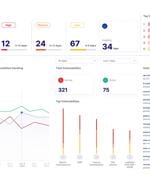Security News

According to the Statista Cloud Market Share publication, Amazon Web Services, Microsoft Azure, and Google Cloud Platform are the three largest cloud service providers, having captured over 60% of the market between them. The cloud is no cyber security panacea, and data breaches involving the cloud show no sign of abating.

The Cloud Security Alliance released the findings of its latest survey which offers insight into companies' plans regarding cloud and security strategy, cloud services, and cloud-related technologies. "Cloud is a continuously evolving space with new services, strategies, and technologies springing up seemingly overnight. It's imperative that organizations regularly change and adapt their approach to cloud and cloud security," said Hillary Baron, lead author and research analyst, Cloud Security Alliance.

The report found that of companies using multiple cloud platforms, 48% are also taking a hybrid approach by utilizing both public and private clouds. To get a better understanding of what these multi and hybrid cloud environments look like, and to identify the common challenges and opportunities shared by developers, IT teams, and companies working to become cloud-native, 416 US and UK IT decision-makers were surveyed in Q4 2021.

Oxeye provides a cloud-native application security testing solution that is designed to overcome the challenges imposed by the complex nature of modern architectures. Oxeye disrupts traditional application security testing, approaches by offering a contextual, effortless, and comprehensive solution to ensure no vulnerable code ever reaches production.

Google is adding a new defensive layer to protect enterprise workloads running in Google Cloud. It's called Virtual Machine Threat Detection, and will help select Security Command Center customers detect cryptomining malware inside their virtual machines.

Google has announced the public preview of a new Virtual Machine Threat Detection system that can detect cryptocurrency miners and other malware without the need for software agents. A significant problem for developers and enterprises using cloud-based virtual machines is the constant targeting of threat actors who breach servers to install cryptominers.

Online work accounts of News Corporation journalists were broken into by snoops with ties to China, it was claimed today. The cyber-attack "Included the targeting of emails and documents of some employees, including journalists," wrote defense editor Larisa Brown.

A high-severity security vulnerability in Argo CD can enable attackers to access targets' application-development environments, paving the way for stealing passwords, API keys, tokens and other sensitive information. Argo CD is a continuous-delivery platform deployed as a Kubernetes controller in the cloud, and it's used to deploy applications, then continuously monitor them in real time as they run.

The cloud computing market value is set to grow by $287.03 billion from 2020 to 2025, as per the latest report by Technavio. YoY growth: 20.37%. Performing market contribution: North America at 40%. Key consumer countries: US, Germany, China, Japan, and UK. Regional cloud computing market analysis.

Platform9 announced the results of its research, revealing that 91% of survey respondents cite security, consistent management across environments, high availability, and observability as their top concerns for operating cloud-native technologies. The report, which surveyed over 500 technology executives and practitioners, details how enterprises are adopting cloud-native technologies, provides insight into 2022 technology investment priorities, and identifies top concerns to help business leaders and enterprises determine how best to navigate and accelerate their cloud-native initiatives for the rest of the year.